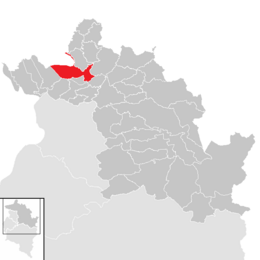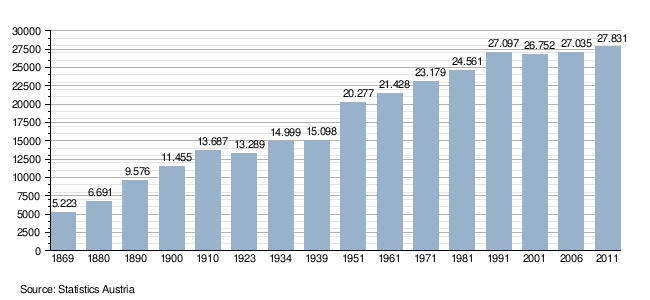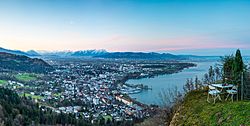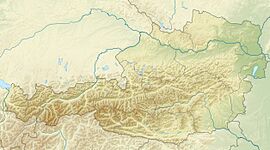Bregenz facts for kids
Quick facts for kids
Bregenz
Breagaz (Alemannic German)
|
|||
|---|---|---|---|
|
Clockwise from top: view of the city, Festspielhaus with stage, aerial view of the city, Oberstadt, Martinsturm
|
|||
|
|||

Location in the district
|
|||
| Country | |||
| State | Vorarlberg | ||
| District | Bregenz | ||
| Area | |||
| • Total | 29.5 km2 (11.4 sq mi) | ||
| Elevation | 427 m (1,401 ft) | ||
| Population
(2018-01-01)
|
|||
| • Total | 29,806 | ||
| • Density | 1,010.4/km2 (2,617/sq mi) | ||
| Demonym(s) | Bregenzer (m.) Bregenzerin (f.) (de) |
||
| Time zone | UTC+1 (CET) | ||
| • Summer (DST) | UTC+2 (CEST) | ||
| Postal code |
6900
|
||
| Area code | 05574 | ||
| Vehicle registration | B | ||
| Website | www.bregenz.at | ||
Bregenz is the capital city of Vorarlberg, which is the westernmost state in Austria. The city is located on the eastern and southeastern shores of Lake Constance. This lake is the third-largest freshwater lake in Central Europe. Bregenz is positioned between Switzerland to the west and Germany to the northwest.
The city of Bregenz sits on a high area that slopes down in steps towards Lake Constance. It is at the base of the Pfänder mountain. Bregenz is an important meeting point for roads that connect the Rhine valley to the German Alps. You can also take cruise ships on Lake Constance from here.
Bregenz is well-known for its yearly summer music festival, the Bregenzer Festspiele. It also hosts a dance festival called Bregenzer Spring.
Contents
History of Bregenz
People first settled in the Bregenz area around 1500 BC. Ancient writings mention the Brigantii, a Celtic group, living in this part of the Alps. Around 500 BC, the Celts built a strong settlement called Brigantion here.
In 15 BC, the Romans took control of Brigantion after several battles. It became a Roman military camp. Around 50 AD, it was made a Roman town called Brigantium. It was also the main base for the Roman navy on Lake Constance. In 259/260 AD, the Alemanni, a Germanic people, destroyed Brigantium. They then settled in the area around 450 AD.
From 610 to 612 AD, Saint Columbanus and Saint Gall worked as missionaries in Bregenz. Starting in 917 AD, a powerful family called the Udalrichinger, who were counts of Bregenz, used the castle as their home. This family ended around 1150 AD. One of their famous members was Saint Gebhard, born in 947, who later became the Bishop of Konstanz.
Around 1170, Hugo of Tübingen (Montfort) started a new town settlement. This town grew bigger in the 13th and 14th centuries, and again from 1650 to 1652.
Bregenz was sold to the Habsburgs in 1451 and again in 1523. It remained under Austrian rule for a long time. There was a short period during the 30 Years' War when Swedish forces, led by Carl Gustaf Wrangel, took over. From 1805 to 1814, Bregenz was ruled by Bavaria.
Important developments happened in the 1800s. A harbor was built on Lake Constance between 1842 and 1850. It was made larger in 1883 and again from 1889 to 1891. Austrian ship services started in 1884. Train services began in 1872, and a railway across the Arlberg mountains opened in 1884.
Since 1726, Bregenz has been the main center for Austrian government in Vorarlberg. In 1919 and 1946, the nearby areas of Rieden-Vorkloster and Fluh became part of Bregenz. During World War II, in 1945, the town was bombed by the Allies, and 72 houses were destroyed.
Population Growth
The population of Bregenz has changed a lot over the years. Here's a look at how it has grown:

Main Sights in Bregenz
Bregenz has many interesting places to see, both in its old upper town and the newer lower town.
Upper Town Attractions
- Old Buildings: You can still see parts of buildings from the 13th and 16th centuries.
- Town Walls: Explore the historic walls that once protected the town.
- Old Town Hall: This building was constructed in 1662.
- Martinsturm (Martin's Tower): This tower was first built by the Romans. It has a chapel with old paintings from 1362. An extra floor was added between 1599 and 1601. It has the biggest onion-shaped Baroque steeple in Central Europe. Inside, there's a Museum of Military History.
- Gothic Parish Church of St. Gall: Its foundations are from before 1380, built in the Romanesque style. It was rebuilt around 1480 and then changed to a Baroque style around 1737.
- Herz-Jesu Parish Church: This church was built between 1905 and 1908.
Lower Town Attractions
- Floating Stage: This unique stage is right on Lake Constance.
- Town Hall: Built in 1686, its front was updated in 1898.
- Gothic Seekapelle (Lake Chapel): A beautiful old chapel near the lake.
- Landhaus: This modern government building was built from 1973 to 1982.
- Former Kornhausmarkt: Originally a market building (1838-1940), it's now a theatre.
- Protestant Church of the Sacred Cross: Built between 1862 and 1864.
- Church of St. Kolumban: A more modern church, built from 1962 to 1966.
- Kunsthaus Bregenz: A museum for modern art, built between 1991 and 1997.
- Tourismushaus: The main tourist information center, built from 1994 to 1998.
In the Vorkloster area, you can find the Maria Hilf parish church (1925–1931) and the Cistercian monastery of Mehrerau. On Gebhardsberg rock, you can see the remains of the Hohenbregenz fortress, which was destroyed in 1647.
Businesses and Services
Bregenz is a busy city with many businesses and services.
International Offices
Several countries have offices here to help their citizens. These include a main office for Turkey, and smaller offices for Belarus, France, Germany, Hungary, Norway, and Switzerland. Nearby towns also host offices for Finland, the United Kingdom, and Brazil.
Schools and Arts Centers
Bregenz has many schools, including four high schools (Gymnasium), and colleges for business and technical skills. There are also vocational schools and an Academy of Social Sciences. For arts and culture, you'll find:
- An adult education center
- State archives (where historical documents are kept)
- A state library
- A state museum
- The Kunsthaus Bregenz (a modern art center)
- Künstlerhaus (another art center)
- The Thurn und Taxis Palace
- Five monasteries
- Heimatwerk (a place that supports traditional crafts)
- Various local newspapers
Public Facilities
The city offers many public spaces and services:
- A large Festival and Congress center
- The Theater am Kornmarkt
- A casino
- A harbor for sailing boats and yachts
- A cable car that takes you up Pfänder mountain for amazing views.
Economy of Bregenz
The economy of Bregenz is mostly made up of small businesses. These businesses work in services, trade, and industry. Some important industries include:
- Textile Industry: For example, Wolford AG, which makes clothing.
- Fittings Manufacturing: Julius Blum GmbH, a company that makes parts for furniture.
- Glass Processing and Machine Construction: Companies that work with glass and build machines.
Tourism is also very important, both in summer and winter. A big draw is the Bregenz Festival, which started in 1946. It has a famous floating stage on the lake, which was modernized in 1979. The Festival and Congress Hall opened in 1980. In winter, people enjoy winter sports on the Pfänder mountain.
Culture and Festivals
Bregenzer Festspiele
The Bregenzer Festspiele is a world-famous summer music festival. It happens every July and August on and around a special stage built on Lake Constance. Over 150,000 people visit Bregenz for this festival each year. The shows on the lake stage change every two years.
Besides the performances on the lake, orchestral concerts and operas also take place in the nearby festival theater. There are also special programs for children and young people. The lake stage (Seebühne) is the largest open-air lake theater in the world. It can hold about 7,000 people.
Bregenz Jazz Festival
Since 2014, the Bregenz Jazz Festival has been held every June at the Kornmarktplatz. It replaced the New Orleans Festival, which took place from 1999 to 2013. The new festival focuses on jazz music instead of blues.
Bregenzer Frühling
Since 1987, the Bregenzer Spring dance festival has been held every year. It takes place between March and June in the Festival Hall of Bregenz. Dance groups from all over the world come to perform their new shows. This festival is one of the most important dance events in Austria.
Other Cultural Highlights
- In 2013 and 2019, parts of a Roman Theatre were found in Bregenz.
- The Galgenbihl (gallow hill) is an old historical site, though it is not widely known today.
Climate in Bregenz
| Climate data for Bregenz (1981–2010, extremes 1948–present) | |||||||||||||
|---|---|---|---|---|---|---|---|---|---|---|---|---|---|
| Month | Jan | Feb | Mar | Apr | May | Jun | Jul | Aug | Sep | Oct | Nov | Dec | Year |
| Record high °C (°F) | 17.5 (63.5) |
20.7 (69.3) |
25.8 (78.4) |
31.2 (88.2) |
32.5 (90.5) |
35.5 (95.9) |
37.5 (99.5) |
36.3 (97.3) |
34.2 (93.6) |
29.4 (84.9) |
25.4 (77.7) |
21.8 (71.2) |
37.5 (99.5) |
| Mean daily maximum °C (°F) | 3.6 (38.5) |
5.0 (41.0) |
9.7 (49.5) |
14.2 (57.6) |
18.9 (66.0) |
21.9 (71.4) |
24.2 (75.6) |
23.5 (74.3) |
19.0 (66.2) |
14.0 (57.2) |
8.0 (46.4) |
4.6 (40.3) |
13.9 (57.0) |
| Daily mean °C (°F) | 0.4 (32.7) |
1.1 (34.0) |
5.0 (41.0) |
9.2 (48.6) |
14.1 (57.4) |
17.3 (63.1) |
19.2 (66.6) |
18.3 (64.9) |
14.2 (57.6) |
10.0 (50.0) |
4.7 (40.5) |
1.6 (34.9) |
9.6 (49.3) |
| Mean daily minimum °C (°F) | −1.6 (29.1) |
−1.1 (30.0) |
2.3 (36.1) |
5.4 (41.7) |
9.9 (49.8) |
13.0 (55.4) |
15.0 (59.0) |
14.7 (58.5) |
11.4 (52.5) |
7.7 (45.9) |
2.6 (36.7) |
−0.3 (31.5) |
6.6 (43.9) |
| Record low °C (°F) | −19.0 (−2.2) |
−23.2 (−9.8) |
−16.0 (3.2) |
−4.7 (23.5) |
−1.8 (28.8) |
2.6 (36.7) |
4.3 (39.7) |
5.4 (41.7) |
2.1 (35.8) |
−3.2 (26.2) |
−10.1 (13.8) |
−15.2 (4.6) |
−23.2 (−9.8) |
| Average precipitation mm (inches) | 71 (2.8) |
75 (3.0) |
100 (3.9) |
114 (4.5) |
146 (5.7) |
182 (7.2) |
191 (7.5) |
177 (7.0) |
148 (5.8) |
105 (4.1) |
108 (4.3) |
102 (4.0) |
1,521 (59.9) |
| Average snowfall cm (inches) | 22 (8.7) |
24 (9.4) |
13 (5.1) |
3 (1.2) |
0 (0) |
0 (0) |
0 (0) |
0 (0) |
0 (0) |
0 (0) |
8 (3.1) |
19 (7.5) |
88 (35) |
| Average relative humidity (%) (at 14:00) | 76.4 | 72.0 | 62.9 | 57.5 | 58.8 | 60.0 | 60.8 | 63.4 | 68.4 | 74.2 | 77.4 | 77.7 | 67.5 |
| Source: Central Institute for Meteorology and Geodynamics | |||||||||||||
| Climate data for Bregenz (1971–2000) | |||||||||||||
|---|---|---|---|---|---|---|---|---|---|---|---|---|---|
| Month | Jan | Feb | Mar | Apr | May | Jun | Jul | Aug | Sep | Oct | Nov | Dec | Year |
| Record high °C (°F) | 17.0 (62.6) |
18.4 (65.1) |
25.8 (78.4) |
26.9 (80.4) |
31.4 (88.5) |
34.6 (94.3) |
36.6 (97.9) |
35.3 (95.5) |
34.2 (93.6) |
27.4 (81.3) |
25.2 (77.4) |
21.8 (71.2) |
36.6 (97.9) |
| Mean daily maximum °C (°F) | 3.4 (38.1) |
4.9 (40.8) |
9.5 (49.1) |
13.3 (55.9) |
18.5 (65.3) |
21.3 (70.3) |
23.7 (74.7) |
23.3 (73.9) |
19.2 (66.6) |
13.3 (55.9) |
7.6 (45.7) |
4.6 (40.3) |
13.6 (56.5) |
| Daily mean °C (°F) | 0.6 (33.1) |
1.5 (34.7) |
5.2 (41.4) |
8.5 (47.3) |
13.5 (56.3) |
16.4 (61.5) |
18.7 (65.7) |
18.2 (64.8) |
14.4 (57.9) |
9.7 (49.5) |
4.6 (40.3) |
1.8 (35.2) |
9.4 (48.9) |
| Mean daily minimum °C (°F) | −1.6 (29.1) |
−0.9 (30.4) |
2.2 (36.0) |
4.8 (40.6) |
9.3 (48.7) |
12.2 (54.0) |
14.5 (58.1) |
14.4 (57.9) |
11.1 (52.0) |
7.2 (45.0) |
2.3 (36.1) |
−0.3 (31.5) |
6.3 (43.3) |
| Record low °C (°F) | −19.0 (−2.2) |
−14.4 (6.1) |
−15.6 (3.9) |
−3.5 (25.7) |
−0.3 (31.5) |
4.5 (40.1) |
7.0 (44.6) |
5.8 (42.4) |
2.2 (36.0) |
−3.4 (25.9) |
−9.7 (14.5) |
−14.8 (5.4) |
−19.0 (−2.2) |
| Average precipitation mm (inches) | 79.1 (3.11) |
76.0 (2.99) |
86.1 (3.39) |
124.2 (4.89) |
146.7 (5.78) |
203.4 (8.01) |
191.0 (7.52) |
162.3 (6.39) |
138.2 (5.44) |
108.5 (4.27) |
120.2 (4.73) |
94.6 (3.72) |
1,530.3 (60.25) |
| Average snowfall cm (inches) | 27.5 (10.8) |
23.4 (9.2) |
13.8 (5.4) |
5.7 (2.2) |
0.0 (0.0) |
0.0 (0.0) |
0.0 (0.0) |
0.0 (0.0) |
0.0 (0.0) |
0.4 (0.2) |
7.8 (3.1) |
22.6 (8.9) |
101.2 (39.8) |
| Average precipitation days (≥ 1.0 mm) | 11.1 | 8.9 | 10.6 | 12.8 | 13.1 | 15.3 | 15.3 | 12.7 | 10.6 | 9.9 | 11.2 | 11.3 | 140.8 |
| Average relative humidity (%) (at 14:00) | 76.6 | 72.9 | 62.3 | 57.9 | 57.3 | 59.5 | 59.6 | 62.1 | 65.6 | 73.6 | 76.1 | 77.3 | 66.7 |
| Mean monthly sunshine hours | 58.4 | 82.2 | 118.5 | 156.4 | 206.6 | 195.4 | 226.3 | 223.1 | 155.9 | 104.3 | 59.8 | 43.5 | 1,630.4 |
| Percent possible sunshine | 30.0 | 30.1 | 33.9 | 41.1 | 47.8 | 44.8 | 51.5 | 54.9 | 44.9 | 35.6 | 25.1 | 22.1 | 38.5 |
| Source: Central Institute for Meteorology and Geodynamics | |||||||||||||
Transportation in Bregenz
Bregenz has good transport links.
Train Stations
There are three train stations in the city. The main one is Bregenz railway station. It's a stop on the Vorarlberg railway line, which runs north to south through Vorarlberg. The harbor of Bregenz is right next to Bregenz Hafen railway station, which is on the same line. A third station, Bregenz Riedenburg, is further south.
Bregenz station is served by regional trains (S1 and S3 of Vorarlberg S-Bahn), the S7 service from St. Gallen S-Bahn, and faster REX 1 trains. Long-distance EuroCity and Railjet trains also stop here. The other two stations are only for regional trains. These regional train services are also part of the Bodensee S-Bahn.
Cable Car
The Pfänderbahn is a cable car that goes up to Pfänder mountain. Its starting point is in Bregenz.
Sports in Bregenz
Bregenz is home to a few sports teams:
- A1 Bregenz HB is a handball team.
- SC Bregenz is the city's football (soccer) team. They play in the Austrian Regional League, which is the third division.
Famous People from Bregenz
Many notable people have connections to Bregenz.
Public Service & Business Leaders
- Wolf Dietrich Raitenau (1559–1617): Prince-Archbishop of Salzburg.
- Josef Fessler (1813–1872): A Roman Catholic Bishop.
- Victor von Ebner (1842–1925): An Austrian scientist who studied anatomy.
- Johann Georg Hagen (1847–1930): A Jesuit priest and astronomer.
- Jodok Fink (1853–1929): A farmer and politician who was the first Vice-Chancellor of Austria.
- Valentin Feurstein (1885–1970): An Austrian general.
- Lorenz Bohler (1885–1973): A surgeon known for his work in accident surgery.
- Maria Stromberger (1898–1957): A nurse who helped prisoners during World War II.
- Hermann Gmeiner (1919–1986): A kind person who started SOS Children's Villages.
- Herbert Sausgruber (born 1946): A former governor of Vorarlberg.
- İlber Ortaylı (born 1947): A Turkish historian and professor.
- Günter Bischof (born 1953): An Austrian-American historian and professor.
- Ernst Fehr (born 1956): An Austrian economist who studies human behavior.
- Anton Amann (1956–2015): An Austrian chemist and professor.
- Hans-Peter Martin (born 1957): A journalist and politician.
- Hanni Rützler (born 1962): A scientist who researches food trends.
Artists and Performers
- Johann Conrad Dorner (1810–1866): An Austrian painter.
- Kaspar Albrecht (1889–1970): An architect and sculptor.
- Karl Michael Vogler (1928–2009): An actor.
- Sieghardt Rupp (1931–2015): An actor.
- Robert Schneider (born 1961): A writer of novels and poems.
- Stefan Sagmeister (born 1962): A famous graphic designer.
- Markus Gasser (born 1967): A literary scientist and author.
- Arno Geiger (born 1968): An Austrian novelist.
- Roman Rafreider (born 1969): An Austrian television host.
- Christof Unterberger (born 1970): A cellist and film composer.
- Maria Anwander (born 1980): A modern artist.
- Lukas Birk (born 1982): A photographer.
- Kian Soltani (born 1992): A talented cellist.
- Jakob Kasimir Hellrigl (born 1992): A rapper known as Candy Ken.
Sports Figures
- Georg Bilgeri (1873–1934): An army officer, mountaineer, and pioneer of skiing in Austria.
- Max Sick (1882–1961): A German strongman and gymnast.
- Patrick Ortlieb (born 1967): A former Olympic gold medalist in alpine skiing.
- Aleksandar Đorđević (born 1981): An Austrian footballer.
- Lucas Mayer (born 1983): An Austrian former handball player.
- Robert Weber (born 1985): A handball player for Austria.
- Philipp Netzer (born 1985): An Austrian football coach and former player.
- Dario Baldauf (born 1985): An Austrian footballer.
- Martin Kobras (born 1986): An Austrian football goalkeeper.
- Lukas Katnik (born 1989): An Austrian footballer.
- Manuel Sutter (born 1991): An Austrian footballer.
- Barbara Gasser (born 1989): An Austrian gymnast who competed in the 2012 Olympics.
Twin Towns
Bregenz has special partnerships with other towns around the world. These are called "twin towns" or "sister cities."
 Bangor, Northern Ireland – There are many exchange trips between Bregenz and Bangor.
Bangor, Northern Ireland – There are many exchange trips between Bregenz and Bangor. Acre, Israel
Acre, Israel
Images for kids
See also
 In Spanish: Bregenz para niños
In Spanish: Bregenz para niños






















